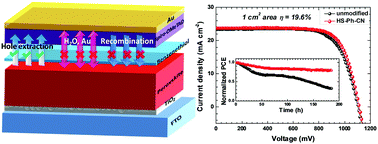当前位置:
X-MOL 学术
›
Energy Environ. Sci.
›
论文详情
Our official English website, www.x-mol.net, welcomes your
feedback! (Note: you will need to create a separate account there.)
Interfacial benzenethiol modification facilitates charge transfer and improves stability of cm-sized metal halide perovskite solar cells with up to 20% efficiency†
Energy & Environmental Science ( IF 32.4 ) Pub Date : 2018-04-24 00:00:00 , DOI: 10.1039/c8ee00754c Jianfeng Lu 1, 2, 3 , Xiongfeng Lin 2, 3, 4, 5 , Xuechen Jiao 2, 3, 5, 6, 7 , Thomas Gengenbach 3, 8, 9 , Andrew D. Scully 3, 8, 9 , Liangcong Jiang 2, 3, 5, 6 , Boer Tan 2, 3, 4, 5 , Jingsong Sun 2, 3, 5, 6 , Bin Li 2, 3, 5, 6 , Narendra Pai 1, 2, 3 , Udo Bach 2, 3, 4, 5, 8 , Alexandr N. Simonov 1, 2, 3, 5, 10 , Yi-Bing Cheng 2, 3, 5, 6, 11
Energy & Environmental Science ( IF 32.4 ) Pub Date : 2018-04-24 00:00:00 , DOI: 10.1039/c8ee00754c Jianfeng Lu 1, 2, 3 , Xiongfeng Lin 2, 3, 4, 5 , Xuechen Jiao 2, 3, 5, 6, 7 , Thomas Gengenbach 3, 8, 9 , Andrew D. Scully 3, 8, 9 , Liangcong Jiang 2, 3, 5, 6 , Boer Tan 2, 3, 4, 5 , Jingsong Sun 2, 3, 5, 6 , Bin Li 2, 3, 5, 6 , Narendra Pai 1, 2, 3 , Udo Bach 2, 3, 4, 5, 8 , Alexandr N. Simonov 1, 2, 3, 5, 10 , Yi-Bing Cheng 2, 3, 5, 6, 11
Affiliation

|
Metal halide perovskite solar cells (PSC) exhibit outstanding power conversion efficiencies when fabricated as mm-sized devices, but creation of high-performing large-area PSCs that are stable under operating conditions on a sufficiently long timescale still presents a significant challenge. We demonstrate herein that modification of the interface between the perovskite and a spiro-OMeTAD hole-transporting material with commercially available para-substituted benzenethiol molecules facilitates fabrication of cm-sized PSCs with both improved efficiency and stability. Comprehensive analysis using specialised and conventional physical characterisation techniques has been undertaken to demonstrate that band alignment at the perovskite surface can be tuned to improve the solar cell efficiency via adsorption of benzenethiols with a significant dipole moment. Moreover, modification of the perovskite with cyano-substituted benzenethiol enhances charge extraction and reduces charge recombination in the devices. These effects enable improvements in the power conversion efficiency of PSCs from 19.0 to 20.2% and from 18.5 to 19.6% under 1 sun AM 1.5G irradiation with 0.16 and 1.00 cm2 apertures, respectively. Most importantly, benzenethiol-modified perovskite solar cells retain more than 80% of the initial performance after 185 h of continuous operation at 50% relative humidity and 50 °C device temperature under 1 sun irradiation, while devices with no interfacial modification undergo continuous deterioration down to 35% of the initial efficiency. These significant improvements are provided by a very simple and highly reproducibile modification procedure that can be readily adopted in other types of PSCs.
中文翻译:

界面苯硫醇改性可促进电荷转移,并以高达20%的效率提高厘米级金属卤化物钙钛矿型太阳能电池的稳定性†
金属卤化物钙钛矿太阳能电池(PSC)在制成mm尺寸的器件时表现出出色的功率转换效率,但是在工作条件下在足够长的时间范围内保持稳定的高性能大面积PSC的产生仍然是一个巨大的挑战。我们在此证明,用可商购的对位取代苯硫醇分子对钙钛矿和螺-OMeTAD空穴传输材料之间的界面进行修饰,可以促进具有改进的效率和稳定性的cm尺寸的PSC的制造。使用专门的和常规的物理表征技术综合分析已进行,以证明带排列在所述钙钛矿表面可以被调谐,以提高太阳能电池的效率通过具有明显的偶极矩的苯硫酚吸附。而且,用氰基取代的苯硫醇对钙钛矿的改性增强了电荷提取并减少了器件中的电荷重组。这些效果使得在1个太阳光1.5G,0.16和1.00 cm 2的太阳辐射下,PSC的功率转换效率从19.0%提高到20.2%,从18.5%提高到19.6%。孔,分别。最重要的是,苯硫酚改性的钙钛矿型太阳能电池在50%的相对湿度和50°C的器件温度下,在1次日光照射下连续运行185小时后,仍能保持80%的初始性能,而没有界面改性的器件会不断退化。达到初始效率的35%。这些重要的改进是通过非常简单且高度可重复的修改程序提供的,该修改程序可轻松用于其他类型的PSC。
更新日期:2018-04-24
中文翻译:

界面苯硫醇改性可促进电荷转移,并以高达20%的效率提高厘米级金属卤化物钙钛矿型太阳能电池的稳定性†
金属卤化物钙钛矿太阳能电池(PSC)在制成mm尺寸的器件时表现出出色的功率转换效率,但是在工作条件下在足够长的时间范围内保持稳定的高性能大面积PSC的产生仍然是一个巨大的挑战。我们在此证明,用可商购的对位取代苯硫醇分子对钙钛矿和螺-OMeTAD空穴传输材料之间的界面进行修饰,可以促进具有改进的效率和稳定性的cm尺寸的PSC的制造。使用专门的和常规的物理表征技术综合分析已进行,以证明带排列在所述钙钛矿表面可以被调谐,以提高太阳能电池的效率通过具有明显的偶极矩的苯硫酚吸附。而且,用氰基取代的苯硫醇对钙钛矿的改性增强了电荷提取并减少了器件中的电荷重组。这些效果使得在1个太阳光1.5G,0.16和1.00 cm 2的太阳辐射下,PSC的功率转换效率从19.0%提高到20.2%,从18.5%提高到19.6%。孔,分别。最重要的是,苯硫酚改性的钙钛矿型太阳能电池在50%的相对湿度和50°C的器件温度下,在1次日光照射下连续运行185小时后,仍能保持80%的初始性能,而没有界面改性的器件会不断退化。达到初始效率的35%。这些重要的改进是通过非常简单且高度可重复的修改程序提供的,该修改程序可轻松用于其他类型的PSC。











































 京公网安备 11010802027423号
京公网安备 11010802027423号